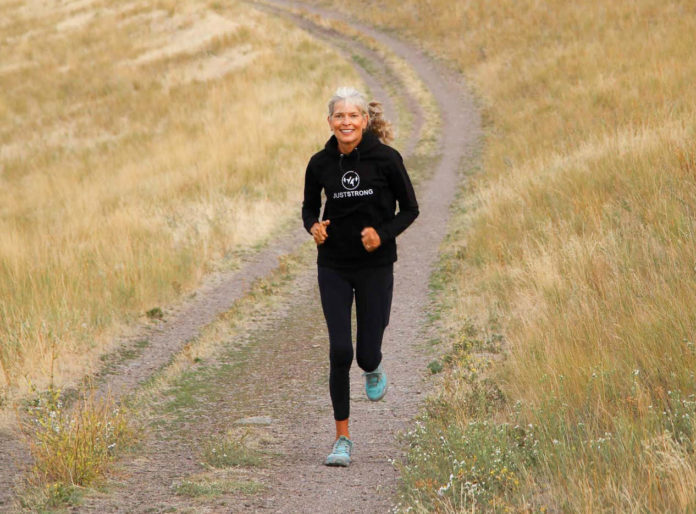Have you been told it is bad for your joints or you shouldn’t run at your age? Maybe you have tried and it is uncomfortable, you are sore for days after or it just doesn’t feel right.
I am a Doctor of Physical Therapy and I am here to tell you: it is not too late, running is not dangerous and, in fact, running can build resilience in your joints. You just have to go into it with some patience, a plan, and some tools to help you ease into it.
In this article, I have put together some quick tips on mindset and form as well as a gradual and safe guide so you can get started running today… and still be able to walk tomorrow!!
Mindset
Here is where I am going to give you a little tough love… It doesn’t matter what you could do in high school or college. Your body and abilities have changed and it is time to embrace you NOW! Shift your mindset to focus on what you CAN do now and celebrate ALL your accomplishments along the way, no matter how small or different or slow they feel.
And while we are on the topic, let’s take the focus off how slow or out of shape you think you are. Every runner, no matter how fast/slow/beginner/elite, will always be striving for better. It is in your best interest to think positively: ‘Yes, I am doing this thing’ vs ‘But I am really slow!’ More on this later!
Bottom line: focus on where you are now and celebrate your progress week to week or month to month! Commend yourself for trying and be patient!
Running Form
Let’s get away from thinking there’s one perfect way to run. Just watch the Olympics and you will see loads of different running styles/forms and, I would argue, they are doing just fine. There are a few tips that I find to be pretty universal when working with runners, which I explain below.
First, here is an easy formula to keep in mind:
More muscle activation = softer landing/less impact on joints = less discomfort and more fun!
Lean Forward, Get Your Feet Under You
Practice leaning forward from your ankles (not your hips) and landing with your feet underneath vs out in front of your body. This naturally shortens your stride, engages more muscles and helps you land softer, ultimately decreasing forces on the joints!
Tip: Imagine leaning into a hill or the wind. Try it as a warm-up drill: Lean forward from the ankles and “fall” into a few steps. Repeat 10-15 times, switching up the leading leg.
Plant and Peel Off Your Big Toe
Planting and peeling off your big toe is kind of like magic (my clients’ words, not mine)! Not only will you use more muscles in your feet, but your big toe is connected by fascia all the way up through your core muscles and even into your throat and tongue. How cool is that?! Many of my clients have seen amazing results using only this simple cue!
Tip: Using the big toe plant with downhill running has the effect of “leaning forward” without feeling like you will topple down the hill.
Rotate
Trunk rotation is a huge part of what propels us forward as we run. The muscles of the trunk work in diagonal groups to create this rotation. So rather than thinking about “tightening your core,” focus on allowing healthy rotation of the spine from the shoulders all the way to the hips.
Tip: You can use a slow-motion, exaggerated version of this as a warm-up drill (see video). For an extra balance challenge, come up onto your toes as the back leg drives forward!
Note: You may need extra hands-on work and/or targeted exercises to increase your trunk rotation! See your PT or reach out to me!
Start or Return to Run Guide
I know, we runners love a training program and numbers and being told exactly what to do and when. However, especially when starting out, I encourage clients to tune in, listen to their bodies’ signals and adjust the following variables based on how the last run felt, both during and 24-48 hours after.
Tip: Do not skip your warm-up! Begin with 5-10 mins of brisk walking to get your blood flowing to the working muscles and prime your body for running. Following the walk, you may add some dynamic stretching or any of the drills from above.
Duration (total time): This does not usually include your warm-up, but the total time running or doing walk:run intervals (see below). This will be the first variable you will change based on how your last run went.
Intervals: I start folks on walk:run intervals. Walking intervals actually allow your body to make adjustments and recover from the impact of the run intervals! I will usually start clients on a 3-4 min walking to 1 min running interval. Once people have reached 40-45 mins duration of their starting intervals, then they can start to decrease the walking time and eventually increase the running time.
Speed/Pace: I am going to bring this back to our chat on mindset. I encourage folks to be very chill when it comes to pace when they are starting or returning to running. Remember, we don’t care what you used to be able to do. We care about being able to do this for the long haul! Start at an easy-moderate or “conversational” pace. This means you could easily carry on a conversation with someone.
Tip: Bring a buddy to have a conversation with! Explain you are starting out and need a buddy to help you stay at a conversational pace (remember, don’t preface with “I am slow!” Runners are usually more than happy to support other runners and go at whatever pace they need!
Terrain: This is somewhat intuitive: flat = easy, hills = harder; road = easy, uneven trail = harder. However, if you have a history of achy joints, don’t be afraid to climb some hills! Uphill is less impact, more muscle, and a great way to build strength and resilience to those joints! Of course, you usually have to come back down those hills (remember to plant that big toe!). If downhill is uncomfortable when you are starting out, don’t be afraid to walk. It will get easier!
Example start-up plan (changing duration 1st, then interval ratios)
Week 1: warm-up, 15-25 min 4:1 walk:run intervals, cool down
Week 2: warm-up, 25-35 min 4:1 intervals, cool down
Week 3: warm-up, 35-40 min 4:1 intervals, cool down
Week 4: warm-up, 25-30 min 3:1 intervals, cool down
You may be able to speed up the progression, or you may want to take it slower. Listen to your body’s cues and be patient!
by Natasha Fett, PT, DPT
Disclaimer: This article is intended for informational and educational purposes and does not replace a thorough examination from a licensed physical therapist or doctor. Contact me if you would like my help with getting started running again!




Good tip about that forefoot strike. I’m 52 and still running (mountain running — I love the ups and downs ad the views you get as a reward) and never get sore knees. I always land each short step on my forefoot.
I think the single most damaging thing for your legs is the invention of the so-called cushioning in running shoes. Those thick fat heels that supposedly help you land softer. Humans are made for running, so we don’t need that fat soft heel on a running shoe. Tippy-toeing is the way to go. No injuries, and, best of all, a more efficient use of your energy. When you land on your heel you actually receive a counter-force in your legs!
So lean forward, take short steps, and try to use zero-drop running shoes would be my advice to add to this writeup. (If you’re going to google zero-drop, then also google Chi Running).
See you on the tracks!
RJ
Thanks for sharing, RJ. I am glad you have found what works for you to keep your running for the long haul!
This is exactly what I needed to read today. I was an avid runner and fitness buff since my late 20’s. Just before COVID, I started working in a very stressful job. Then I contracted the virus and got very sick. So over two years my fitness level plummeted, I have been self medicating with alcohol, and now at 68 years, I have felt very down. This feature has sparked my desire to get back to the ‘really fit’ runner I have inside me. Also, I know everything outlined works, including minimal type shoes, and Chi principles that RJ mentions. Thanks a 100 times over for Natasha for reminding me it is never too late to start again.
Hi Paula,
I am so glad this resonated with you! I know I and I am sure many can relate to your story. Thank you so much for sharing!! Please keep in touch and let me know how your running is going!
Hi Natasha! I was reviewing the article again (for motivation) and saw you answered my post. My progress is slower than I would like, but I am moving along. I have to do walk-jog intervals for now, but my distance is a 4.5 mile trail near our home. I have only been getting three to four days a week due to work. I am working towards getting up a half hour earlier and maybe run on the treadmill, which I hate, but it will help I know. It’s dark when I get up, and I don’t feel safe outside alone. Well, thanks for your kind words. I will keep going until I can run the entire trail! 😉 Paula
You are doing great, Paula! Keep up the good work!
Hi there. Good article, but I am very confused as to what plant and peel off your big toe actually is!? The corresponding video doesn’t really show what it is.
Hi Rae, Thanks for reaching out!
So when we wear shoes, we often lose touch with our feet, resulting in disconnection and disengagement of the muscle within the feet. Feeling the big toe connect to the ground (or shoe) with every step helps to engage muscles not only in the foot but up the kinetic chain (legs, inner thigh, pelvic floor, core). As I said above: more muscle activation = softer landing/less impact on joints.
Further, the big toe should be the last part to come off the ground as you push off to propel yourself forward. These are things that naturally happen in gait/running, but modern humans have lost touch with due to always wearing shoes!
Hope this helps!!
Yes, I think this makes more sense. I will give it a try on my next run. Thanks!
Of course! Let me know how it goes!!